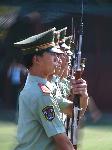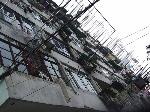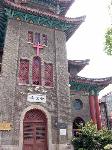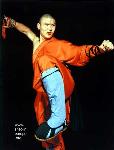- Getting around Lijiang. Dont stay in the Old Towns more than 2 days, there is nothing to do. KRISS Oct 9, 2013 05:46
- 2013 Beijing Temple Fair BENNYLAU Feb 26, 2013 03:29
- Malaysian traveling from KUL - LAX vis Shanghai PVG ZATI_DY Jan 3, 2013 20:15
Photographs of Shanghai Part One
- Views: 9946
- |Vote: 0 0
- |Add to Favorites
- |Recommend to Friends
The Policeman’s Hat
I’d sent a text message to Kevin, my friend in Shanghai, that I was on the train from Hangzhou and would be arriving in Shanghai before too long. He was expecting me and made his way immediately to Shanghai’s train station. I hadn’t given him an exact arrival time, so he had to check the station information board to see when I’d get there.
Shanghai, being an ultra-modern city, has something most Chinese train stations don’t have – a bright train arrival information board. A flashy electronic display presides over the station exit gates, allowing people waiting for passengers to anticipate when their friends and family are likely to emerge. The trouble with the display, Kevin told me later, is typical of what, in his opinion, is wrong with Shanghai in general – it’s all for show. Shanghai is home to some of the world’s most impressive gadgets – walk along the Bund now in the evening and you’ll see a TV that covers half a building projecting its limp display over the Huangpu River – but try to find something truly useful, said Kevin, and you’re stuck.
The arrivals board shines clearly in the evening, but when the morning sunlight hits the display screen, the lights are rendered useless and nothing can be seen. In frustration, Kevin signalled a station guard and asked him when the 9.00 train from Hangzhou was due to arrive. The guard raised his gloved hand and pointed to the arrivals board – “the information’s all up there”, he said.
“But I can’t read that in the sunlight”, Kevin said. The unsympathetic guard continued to point to the board. “It’s all up there”, he said again.
Kevin began to get frustrated. “Alright”, he said. “Tell me, can you read what’s written up on the board, and tell me when the train from Hangzhou will come in?”
The guard glanced up at the arrivals display, scratched his chin, and took off his hat. There, stuck to the inside of his cap, was a printed version of the train schedule.
The guard peered into his hat, replaced it firmly on his head, and looked back at Kevin.
“11.30”, he said.
Shanghai Suburbia
Shanghai, it is said by those who love her, is a great city. Although it doesn’t count amongst China’s many ancient cities like Beijing, Nanjing and Xi’an, it is said to have a cultural tradition all of its own – and with something like 20,000,000 people living within its boundaries, that’s a culture shared by more people than populate some entire countries.
With so many people, urban sprawl is profound. I wasn’t in a position to be able to afford luxury accommodation while staying in Shanghai, and so upon my arrival had to switch straight to the light rail network in order to make my way deep into the suburbs to check into a hotel that fit my price range.
Shanghai’s light rail network is considered to be a model system – it is efficient and modern, and reasonably comprehensive. Its flaw is a slightly complicated ticketing procedure, which requires the purchase of a card over the counter of precisely the right value, swiping the card over a poorly identified card reader, and then inserting the card in a less well identified slot upon leaving the system. Locals do fine, but people who might otherwise consider themselves to be relatively familiar with the modern world, such as myself, are often left waving the card around uselessly at the unrelenting gate until a local arrives to show you what to do. People say you’ll never know how much of a farmer you are until you reach Shanghai.
The view from the rail above Shanghai is of the city’s glorious mess – none of Beijing’s precise rows here, just block after block of apartments scattered in random patterns across Shanghai’s cityscape. All together, their sheer number makes for an impressive spectacle – just as much so as Shanghai’s parade of high-tech skyscrapers.
We finally arrived at the little inn where I’d spend the night. The Pinka Hotel is nestled deep in Wenshui Dong Lu, and seemed more than comfortable – spacious wooden-decked rooms with balconies, and my room featured a huge wetroom-style bathroom complete with toilet, shower, and a photograph of a nude Shanghai girl printed onto one of the broad bathroom tiles.
Duolun Road
Shanghai’s Hongkou district seems far more peaceful than other bustling areas of the city – and its central attraction, the stately old Duolun Road, counts as Shanghai’s own Culture Street. Its original claim to fame comes from its literary past, dating back to its glory days as a prosperous and attractive avenue for writers back in the early 20th century. A number of great names in the Chinese literary world took up residence there, but undoubtedly the most famous of these is Lu Xun, made a hero of the people by the administration in recognition of his masterfully subtle depictions of the struggles of the Chinese working class and peasantry. Nowadays his statue graces the street, as do those of a number of his contemporaries, and he is further commemorated in Lu Xun Park nearby Duolun Road.
Nowadays, the street is something of a museum to itself – there is no traffic, and the old villas that used to house those great writers of the ‘New Cultural Movement’ are fully restored in their original colonial beauty – a fact that recalls a Shanghai overrun with self-serving foreign businessmen, a situation not very unlike that which Shanghai faces today. Visitors can buy antiques from one of numerous little stores that will open as you pass by if the shopkeeper is on a break, or just wander around enjoying the photographs of old Shanghai that adorn periodic displays.
Possibly the most interesting building on the road is a church – the Hongde Temple at number 59. To call it a church and a temple in the same breath is no mistake – architecturally speaking, the building is a perfect amalgamation of the two; a front steeple of grey brick adorned with a red cross is capped with Chinese eaves in green with red trim; crimson cross-hatching over the windows recalls those of many ancient Chinese buildings seen elsewhere in the country, but never on a Christian structure. It’s the accomplishment of an American missionary and was built in 1928, specifically for the purpose of figuring a Christian building in a recognisably sacred style in traditional Chinese terms. It provides a nice contrast to the arrogance and grandeur of the palatial bank buildings on the Bund.
Godly’s
I’m a vegetarian, without being too fussy about it – I simply prefer my diet of vegetables, tofu and nuts when available. Despite China’s vegetarian history (there are three distinct traditions of vegetarian cooking in China – Buddhist, Imperial, and folk, the third of which is most plainly interpreted as being too poor to afford meat) finding food that’s actually free of animal products is tough. Most meat-free dishes are fried in animal oil (the poor pig carries most of this burden), and otherwise vegetarians are regularly frustrated by the one cardinal principle of Chinese traditional cooking that dates from ancient time – “flavour meat dishes with vegetables, and flavour vegetable dishes with meat”. It’s enough to elicit a heartfelt groan from many a foreign greentooth.
Fortunately, sympathetic entrepreneurs and devotees of the Buddha have opened purely vegetarian fare restaurants in many of China’s cities – drop in at a temple for help if you get caught – and in Shanghai, the ostentatiously monickered Godly’s is one upmarket solution to the problem. Godly’s offers a feast for anyone who doesn’t eat meat but secretly wishes they didn’t have to miss out on some of the yummier sounding Chinese dishes. Imperial tradition food employs techniques of soy cooking to emulate real meat, and so the Godly’s menu accordingly features all the favourite Chinese meals under the sun – from Lamb Skewers to Sweet & Sour Pork – all crafted to taste like the real thing without any slaughter or bad karma involved.
The Naughty Monks
I was eating at Godly’s with a local friend and a rather beautiful foreign-born ethnically Chinese girl, and noticed a group of monks giggling at a nearby table. Impossibly, they appeared to be drunk – although many Buddhist restaurants don’t serve alcohol on principle, Godly’s does and I began to suspect that this bunch of head-shaven, safron-robed devotees of the fo had secretly opened a bottle or two of Shi Hao – a Chinese-produced version of New Zealand’s famous Steinlager brand that is sold in the restaurant. Perhaps they were just innocently enjoying the evening, but it did appear rather undignified for those who had supposedly foregone all material things – something that is probably unthinkable in a city such as Shanghai.
The head monk of the famous Shaolin temple happens to be a personal friend of mine – I remembered, as I watched the naughty monks, that he’d told me that in modern times, most monks didn’t want for much – not for reasons of spiritual purity, but because a lot of temples are quite rich and provide many modern luxuries. Although it’s forbidden for a monk to have any possessions, there’s nothing in the rules to stop him from, say, using a laptop computer and mobile phone that belongs to the temple and is his to use on permanent loan.
Outside, I stood next to my dinner partners as the monks spilled onto the street in their billowing costumery, bright and cheerful as the Laughing Buddha himself. As they assembled close by, they noticed the girl I was with and giggled amongst themselves as they made sideways glances in her direction. Eventually one gathered up his robes and his courage and walked across to ask some questions – “You’re not Chinese, are you? You speak Mandarin? Where are you from? Do you believe in the Buddha?” He glanced back at his mates behind him cheekily as he spoke.
It appeared to me to be the ultimate symbol of Shanghai – there, on Nanjing Xi Lu near the Art Museum, a bunch of monks were trying to pick up a pretty girl.








 Copyright © 1998-2025 All rights reserved.
Copyright © 1998-2025 All rights reserved.
1.
Aug 17, 2006 22:58 Reply
FRANKDYB said:
its a nice report for us not yet been to shanghai city
2.
Aug 11, 2006 20:58 Reply
CONNY129 said:
It's great to read your travelogue again :)